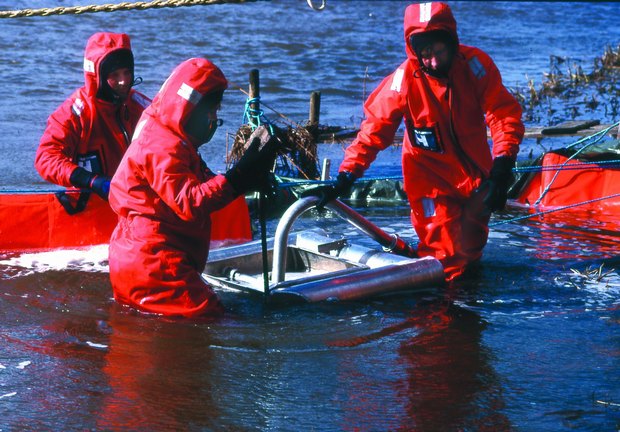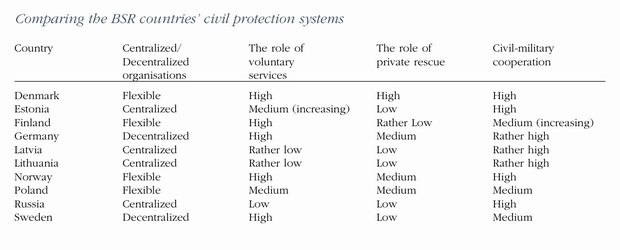
Oil spills provide a growing potential threat to the Baltic Sea and its costal areas. Often cross-border cooperation is needed in responding to such accidents. Compatible equipment and joint training helps in such situations.
This is the world of 'civil protection'. The concept, which is derived from EU vocabulary, refers to protection for people, the environment, and property in the event of man-made, technological and natural disasters. Yet, civil protection is much more than simply the response to acute emergencies. An effective civil protection system is necessarily multi-sectoral and multi-dimensional, starting from proper spatial and physical planning and preventive solutions, and ending in effective restoration. This requires clear-cut legislation and an effective division of labour, as well as workable coordinative mechanisms, bodies and mutual assistance systems across different ministries and agencies.
Nevertheless, in every country a specific system of civil protection exists, with its own main responsible authorities and institutions. Within the EU, civil protection remains a responsibility of the Member States. In spite of this, a specific EU-level for civil protection has emerged, not only in terms of the vocabulary used, but also in terms of institutions. Since 2001 a Community Mechanism to Facilitate Reinforced Cooperation in Civil Protection Assistance Interventions, which includes obligations both for the Commission and the Member States, has existed.
Cooperation has moreover already gone far beyond the simple joint-coordination of international interventions. Indeed, it has brought national civil protection systems, to some extent at least, into line. A kind of 'epistemic community' has thus emerged, and even in the absence of any 'coercive' mechanism EU-integration can be said to be proceeding, albeit slowly, in the area of civil protection. Indeed, the EU's role has remained that of a network builder, coordinator and harmonizer, rather than an operative actor. Moreover, it has to compete with similar aspirations in the UN and NATO.
The safety dimension of spatial planning and regional development has in recent years become one of Nordregio's priorities. Nordregio is one of the initiators of the Interreg IIIB part-financed Eurobaltic Project for Civil Protection in the Baltic Sea Region (2003-2007). The project is led by the Swedish Rescue Services Agency and it is a part of the Council for Baltic Sea States civil protection programme. For more information and publications, see www.eurobaltic.srv.se Nordregio is also the lead partner in the project Civil Protection Early Warning (2007), financed by the EU's DG Environment, and in the project Towards a Regional Strategy for Critical Infrastructure Protection in the Baltic Sea Region (2007), financed by the EU's DG, Freedom, Justice and Security. For more information, contact: Christer Pursiainen.
The national systems are still far removed from each other. This is especially striking in the Baltic Sea Region (BSR), with its mixture of new, old and older EU countries. This is particularly evident in respect of the difference between the Nordic countries with their cooperation traditions, and the post-socialist countries with their centralized legacy. Differences in history, culture, basic political and administrative systems, size, location and specific problems are also reflected in the respective countries' civil protection cultures.
The civil protection systems can be compared by looking at several variables. Perhaps the most obvious is whether the civil protection duty is led, coordinated and organized by a central national authority, or whether the regional and municipal authorities retain considerable legal and operational responsibility. An identifiable pattern here is that the systems in the Nordic countries, Poland and Germany are flexible or decentralized in this respect, while the systems in the Baltic States and Russia are rather centralized.
Other comparable variables include whether the voluntary organisations or private rescue services are an integral part of the official civil protection system or not. The Nordic countries and Germany clearly place a significant level of reliance on voluntary
organisations, followed by Poland and Estonia, while in other countries the situation is somewhat reversed. Denmark, in turn, is on its own when it comes to the role of private rescue services.
Yet another variable is whether close cooperation exists between the civil protection and military authorities. All of the countries, though presumably for different historical reasons, seem to have this level of cooperation as a rather important part of their civil protection systems.
In any case, differences are clear. One could see the differences as encompassing the possibility to learn from each other's experience. On the other hand one could suggest that they create a significant hindrance to further integration in the field of civil protection.
A concrete challenge then is that the differences are bound to cause practical problems especially when dealing with issues with cross-border implications, such as responding to oil spills. For instance, while there is a need for joint planning and training in this field, the authorities may find it difficult to cooperate if the responsibility in one country lies at the central level and in other at the municipal level. Similarly, voluntary organisations in one country may find no counterparts in another, where this dimension of civil protection is not fully appreciated.
In some cases, these cooperation problems may be reflected in the ability to respond to cross-border emergencies in the best way. Therefore, the EU's effort to facilitate cooperation and interoperability between the national civil protection systems is most welcome.

By Christer Pursiainen, previous at Nordregio